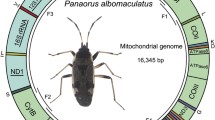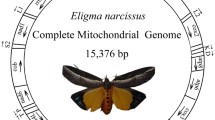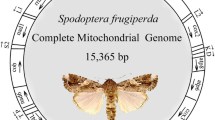Abstract
The control regions of mitochondrial DNA of two insects, Schistocerca gregaria and Chorthippus parallelus, have been isolated and sequenced. Their sizes are 752 by and 1,512 bp, respectively, with the presence of a tandem repeat in C. parallelus. (The sequences of the two repeats are highly conserved, having a homology of 97.5%.) Comparison of their nucleotide sequences revealed the presence of several conserved sequence blocks dispersed through the whole control region, showing a different evolutionary pattern of this region in these insects as compared to that in Drosophila. A highly conserved secondary structure, located in the 3′ region near the small rRNA gene, has been identified. Sequences immediately flanking this hairpin structure rather than the sequences of this structure themselves are conserved between S. gregaria/C. parallelus and Drosophila, having a sequence consensus of “TATA” at 5′ and “GAA(A)T” at 3′. The motif “G(A)nT” is also present in the 3′ flanking sequences of mammalian, amphibian, and fish mitochondrial L-strand replication origins and a potential plant mitochondrial second-strand-replication origin, indicating its universal conservation and functional importance related to replication origins. The stem-and-loop structure in S. gregaria/C. parallelus appears to be closely related to that found in Drosophila despite occupying a different position, and may be potentially associated with a second-strand-replication origin. This in turn suggests that such a secondary structure might be widely conserved across invertebrates while their location in the control region may be variable. We have looked for such a conserved structure in the control regions of two other insects, G. firmus and A. mellifera, whose DNA sequences have been published, and their possible presence is discussed.
Mitochondrial control regions characterized to date in five different insect taxa (Drosophila, G. firmus, A. mellifera, S. gregaria, and C. parallelus) may be classed into two distinct groups having different evolutionary patterns. It is observed that tandem repetition of regions containing a probable replication origin occurred in some species from disjunct lineages in both groups, which would be the result of convergent evolution. We also discuss the possibility of a mechanism of “parahomologous recombination by unequal crossing-over” in mitochondria, which can explain the generation of such tandemly repeated sequences (especially the first critical repetition) in the control region of mtDNA, and also their convergent evolution in disjunct biological lineages during evolution.
Similar content being viewed by others
References
Anderson S, de Bruijn MHL, Coulson AR, Eperon IC, Sanger F, Young IG (1982) Complete sequence of bovine mitochondrial DNA: conserved features of the mammalian mitochondrial genome. J Mol Biol 156:683–717
Borror DJ, Triplehorn CA, Johnson NF (1989) An introduction to the study of insects, 6th ed. Saunders College Publishing, Philadelphia
Boyce TM, Zwick ME, Aquadro CF (1989) Mitochondrial DNA in the bark weevils: size, structure and heteroplasmy. Genetics 123:825–836
Brown GG, DesRosiers LJ (1983) Rat mitochondrial DNA polymorphism: sequence analysis of a hypervariable site for insertions/ deletions. Nucleic Acids Res 11:6699–6708
Brown GG, Gadaleta G, Pepe G, Saccone C, Sbisa E (1986) Structural conservation and variation in the D-loop-containing region of vertebrate mitochondrial DNA. J Mol Biol 192:503–511
Brown WM (1985) The mitochondrial genome of animals. In: Maclntyre RJ (ed) Molecular evolutionary genetics. Plenum Press, New York, pp 95–130
Buroker NE, Brown JR, Gilbert TA, O'Hara PJ, Beckenbach AT, Thomas WK, Smith MJ (1990) Length heteroplasmy of sturgeon mitochondrial DNA: an illegitimate elongation model. Genetics 124:157–163
Clary DO, Wolstenholme DR (1985) The mitochondrial DNA molecule of Drosophila yakuba: nucleotide sequence, gene organization, and genetic code. J Mol Evol 22:252–271
Clary DO, Wolstenholme DR (1987) Drosophila mitochondrial DNA: conserved sequences in the A + T-rich region and supporting evidence for a secondary structure model of the small ribosomal RNA. J Mol Evol 25:116–125
Clayton DA (1982) Replication of animal mitochondrial DNA. Cell 28:693–705
Cornuet JM, Garnery L, Solignac M (1991) Putative origin and function of the intergenic region between COI and COII of Apis mellifera L. mitochondrial DNA. Genetics 128:393–403
Crozier RH, Crozier YC (1993) The mitochondrial genome of the honeybee Apis mellifera: complete sequence and genome organization. Genetics 133:97–117
de Haas JM, Hille J, Kors F, van der Meer B, Kool AJ, Folkerts O, Nijkamp HJJ (1991) Two potential Petunia hybrida mitochondrial DNA replication origins show structural and in vitro functional homology with the animal mitochondrial DNA heavy and light strand replication origins. Curt Genet 20:503–513
Densmore LD, Wright JW, Brown WM (1985) Length variation and heteroplasmy are frequent in mitochondrial DNA from parthenogenetic and bisexual lizards (Genus Cnemidophorus). Genetics 110:689–707
Desjardins P, Morais R (1990) Sequence and gene organization of the chicken mitochondrial genome. A novel gene order in higher vertebrates. J Mol Biol 212:599–634
Desjardins P, Morais R (1991) Nucleotide sequence and evolution of coding and noncoding regions of a quail mitochondrial genome. J Mol Evol 32:153–161
Erlich HA (ed) (1989) PCR technology. Principles and applications for DNA amplification. Stockton Press, New York
Gray MW (1989) Origin and evolution of mitochondrial DNA. Ann Rev Cell Biol 5:25–50
Innis MA, Gelfand DH, Sninsky JJ, White TJ (eds) (1990) PCR protocols. A guide to methods and applications. Academic Press, San Diego
Johansen S, Guddal PH, Johansen T (1990) Organization of the mitochondrial genome of Atlantic cod, Gadus morhua. Nucleic Acids Res 18:411–419
La Roche J, Snyder M, Cook DI, Fuller K, Zouros E (1990) Molecular characterization of a repeat element causing large-scale variation in the mitochondrial DNA of the sea scallop Placopecten magellanicus. Mol Biol Evol 7:45–64
Marchant AD (1988) Apparent introgression of mitochondrial DNA across a narrow hybrid zone in the Caledia captiva species-complex. Heredity 60:39–46
McCracken A, Uhlenbusch I, Gellissen G (1987) Structure of the cloned Locusta migratoria mitochondrial genome: restriction mapping and sequence of its DN-1 (URF-1) gene. Curt Genet 11:625–630
Mignotte F, Gueride M, Champagne AM, Mounolou JC (1990) Direct repeats in the non-coding region of rabbit mitochondrial DNA. Involvement in the generation of intra- and inter-individual heterogeneity. Eur J Biochem 194:561–571
Monforte A, Barrio E, Latorre A (1993) Characterization of the length polymorphism in the A + T-rich region of the Drosophila obscura group species. J Mol Evol 36:214–223
Monnerot M, Solignac M, Wolstenholme DR (1990) Discrepancy in divergence of the mitochondrial and nuclear genomes of Drosophila teissieri and Drosophila yakuba. J Mol Evol 30:500–508
Moritz C, Brown WM (1986) Tandem duplication of D-loop and ribosomal RNA sequences in lizard mitochondrial DNA. Science 233:1425–1427
Moritz C, Dowling TE, Brown WM (1987) Evolution of animal mitochondrial DNA: relevance for population biology and systematics. Ann Rev Ecol Syst 18:269–292
Rand DM, Harrison RG (1989) Molecular population genetics of mtDNA size variation in crickets. Genetics 121:551–569
Saccone C, Attimonelli M, Sbisa E (1987) Structural elements highly preserved during the evolution of the D-loop-containing region in vertebrate mitochondrial DNA. J Mol Evol 26:205–211
Saccone C, Pesole G, Sbisa E (1991) The main regulatory region of mammalian mitochondrial DNA: structure-function model and evolutionary pattern. J Mol Evol 33:83–91
Sambrook J, Fritsch EF, Maniatis T (1989) Molecular cloning. A laboratory manual, 2nd ed. Cold Spring Harbor Laboratory Press, New York
Simon C (1991) Molecular systematics at the species boundary: exploiting conserved and variable regions of the mitochondrial genome of animals via direct sequencing from amplified DNA. In: Hewitt GM, Johnston AWB, Young JPW (eds) NATO ASI Series, vol. 57. Molecular techniques in taxonomy. Springer-Verlag, pp 33–71
Smith GP (1976) Evolution of repeated DNA sequences by unequal crossover. Science 191:528–535
Solignac M (1991) Preparation and visualization of mitochondrial DNA for RFLP analysis. In: Hewitt GM, Johnston AWB, Young JPW (eds) NATO ASI Series, vol 57. Molecular techniques in taxonomy. Springer-Verlag, Berlin, pp 295–319
Solignac M, Monnerot M, Mounolou JC (1986) Concerted evolution of sequence repeats in Drosophila mitochondrial DNA. J Mol Evol 24:53–60
Uvarov B (1966) Grasshoppers and locusts. A handbook of general acridology. Volume 1: anatomy, physiology, development phase polymorphism, introduction to taxonomy. Cambridge University Press, London, pp 397–420
Walberg MW, Clayton DA (1981) Sequence and properties of the human KB cell and mouse L cell D-loop regions of mitochondrial DNA. Nucleic Acids Res 9:5411–5421
Wong JFH, Ma DP, Wilson RK, Roe BA (1983) DNA sequence of the Xenopus laevis mitochondrial origins and flanking tRNA genes. Nucleic Acids Res 11:4977–4995
Zannis-Hadjopoulos M, Frappier L, Khoury M, Price GB (1988) Effect of anti-cruciform DNA monoclonal antibodies on DNA replication. EMBO J 7:1837–1844
Author information
Authors and Affiliations
Additional information
Correspondence to: G.M. Hewitt
Rights and permissions
About this article
Cite this article
Zhang, DX., Szymura, J.M. & Hewitt, G.M. Evolution and structural conservation of the control region of insect mitochondrial DNA. J Mol Evol 40, 382–391 (1995). https://doi.org/10.1007/BF00164024
Received:
Accepted:
Issue Date:
DOI: https://doi.org/10.1007/BF00164024




